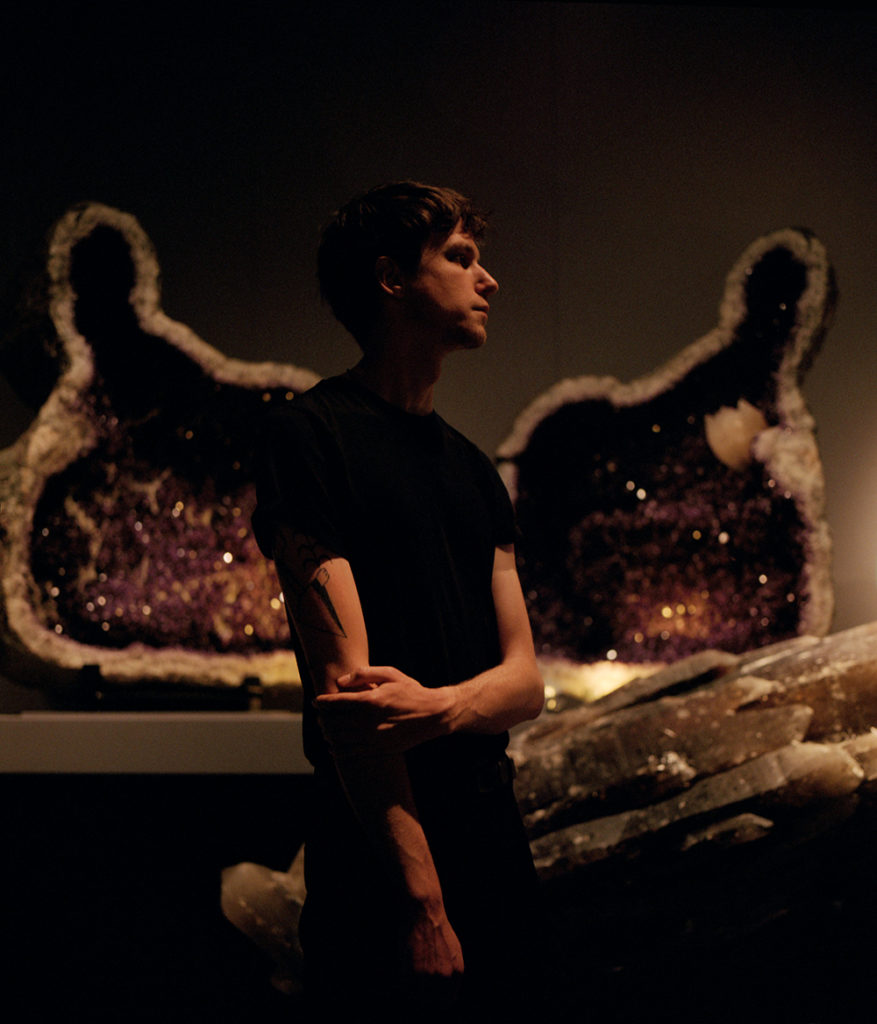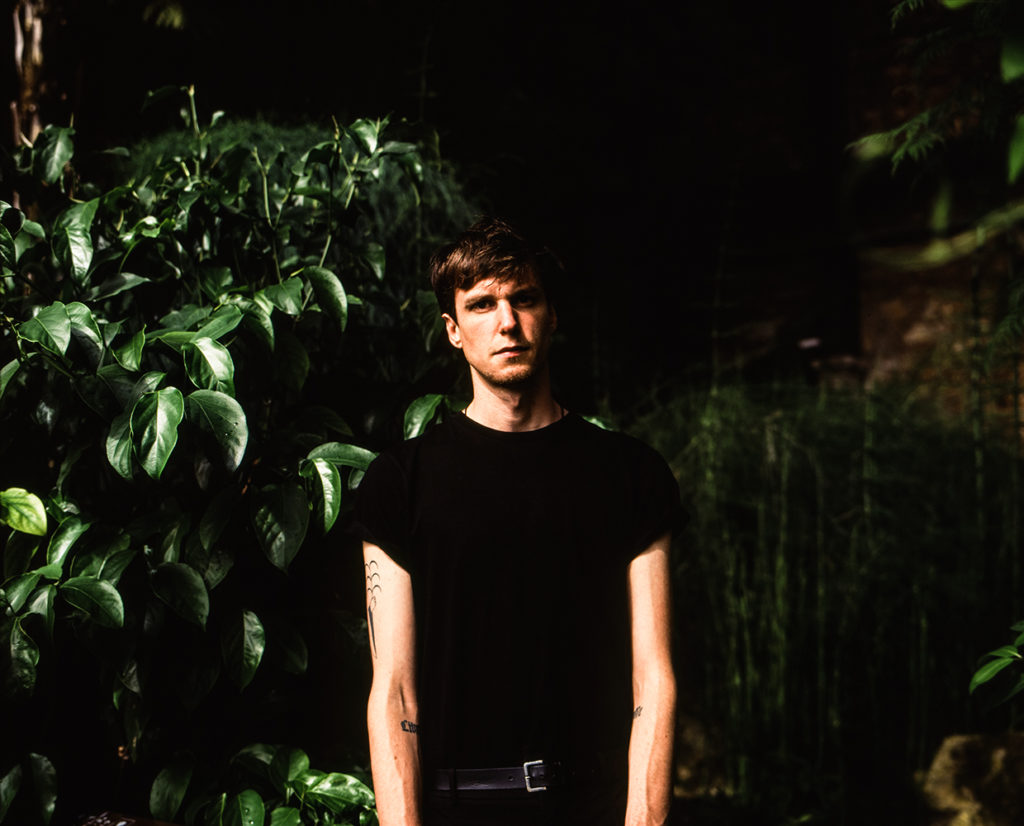In recent years Régimbeau has presented some more quiet and refined compositions, often without relying on any percussion at all. Among them is How Deep Is Our Love?, the latest Mondkopf-release published on French quality-imprint Hands In The Dark a couple of days ago. Fellow artist Martina Lussi, who currently lives in Paris, took the chance to sit down with Régimbeau to discuss his most recent output in detail.
Martina Lussi How did you start producing this album. What was the initial idea and how did you go from there?
Paul Régimbeau I started working on this album after Diana Vidrascu has asked me to compose the music for her short film The Silence of Sirens, an adaptation of a Kafka novel. She showed me a few shots she had filmed, as well as the script. As nothing was edited at this point, I put a very simple set-up in place—a synthesizer and a few effects pedals—, and I got into improvising with these images in my head. Right from the start, I was looking for oscillations and vibrating sounds to fit the grainy aesthetic, that was inherent to the movie, as it was shot in 16mm film. Working with synths and analog effects made sense to me as this set-up would allow the same kind of unexpected variations of color the analog film could offer. Also the very soft colors and photography of Diana’s work inspired me to record some rather positive and uplifting music. Those improvisations were used in the film; and I reworked the material afterwards to create a proper album.
ML The last track on the album, “Inner Fire,” ends with a field recording. Did you also use field recordings in the other pieces? What drives you to do so?
PR There is also field recordings on the first song, “The Last Day On Earth”—it’s the sound of waterfalls. It was through Diana’s work that waterfalls, beaches, and people in the city entered my music. In the end, it didn’t feel as if I was writing music for a movie, rather I was wandering through soundscapes.
ML While listening to the record I was thinking about the way you compose sounds—and I think I found the answer in one of the track titles: “Growing.” Your pieces seem to evolve constantly—there are no breaks, no leaps back- or forwards, no repetitions. Why did you compose this record like that?
PR Since my childhood, repetitive sounds were omnipresent. The sound of airplanes above my parents’ house, the birds singing in the backyard, or the music on records from Tangerine Dream, Terry Riley, or Steve Reich that my parents were listening to at the time. These sounds always stuck with me, and I always felt comfortable creating music in this fashion. I like how this kind of music can change almost subliminally—you can switch from one feeling to another without making the listeners note in the first place. At a certain volume, it’s like controlling one’s mind and body. “Growing” hints at amplifying an inner feeling…
ML The pieces on the album are all around ten minutes long. I think if you compose in the manner you just described, the music needs time to unfold. Did you define a timeframe when you started composing or did you set off and see how far it would go?
PR I was used to have many rules in my music—to integrate breaks, bridges, intros, outros, and so on. But for my last two albums, I got rid of those structures. I prefer to let the themes and textures develop organically, and when I feel I’m where I wanted to be, I slow things down and the song comes to an end.
ML The album was released on vinyl. Do you think about other formats? What would be the perfect format for your sound?
PR It’s funny because I don’t find that vinyl is the best format for my music. I’m a bit obsessive with fidelity and sometimes I feel that the output on vinyl doesn’t match the masters well enough. But it also adds things that have an influence on the listener’s perception in a good way. When I write music, I don’t really think about the format. Usually it’s more that when I have all the songs ready, I struggle with the track listing to make them fit onto a LP.
ML “Death Is Not A Lover” is different from the two tracks before, because there is some kind of a break and there are sounds that seem to be closer to my ears as a listener. Can you tell me more about that?
PR This track is a bit darker. I recorded it with the idea of having something oppressive but still hypnotic. At some point, a white noise came up and I thought I’d exploit it as a break, much like you would do in a techno track. That’s what I’m looking for these days, to delve into the sound and get lost in the undulating frequencies. That’s why I let the sounds breathe without using much equalization now. A lot of frequencies happened by chance and I used them as a guide—I didn’t want to tame them in order to keep the power of the song. That’s why certain sounds might appear very close to the ear. I play a lot with reverbs as well—not to make the sounds prettier, but to build the space.
ML Can you tell me more about the album’s title: How Deep Is Our Love? When did you find this title and how?
PR To be honest, I don’t remember much about it—the title just sprung to my mind. I don’t know why but the music was evoking the images of a sunset on top of a mountain and a feeling of melancholia overwhelmed me. I hope it makes people reflect about the love they give, even if they don’t listen to the music. And maybe some people have to smile because of the Bee Gees reference. Diana’s movie, which was the starting point, has this melancholy attached to someone who’s feeling lost. This feeling inspired me as well.
ML The album’s title and the music as such are hinting at spirituality. Do you think that’s true?
PR Yes, I love the feeling in between sadness and joy—and that’s the feeling I tried to convey. It’s difficult to explain or understand and it always comes and goes in waves.

